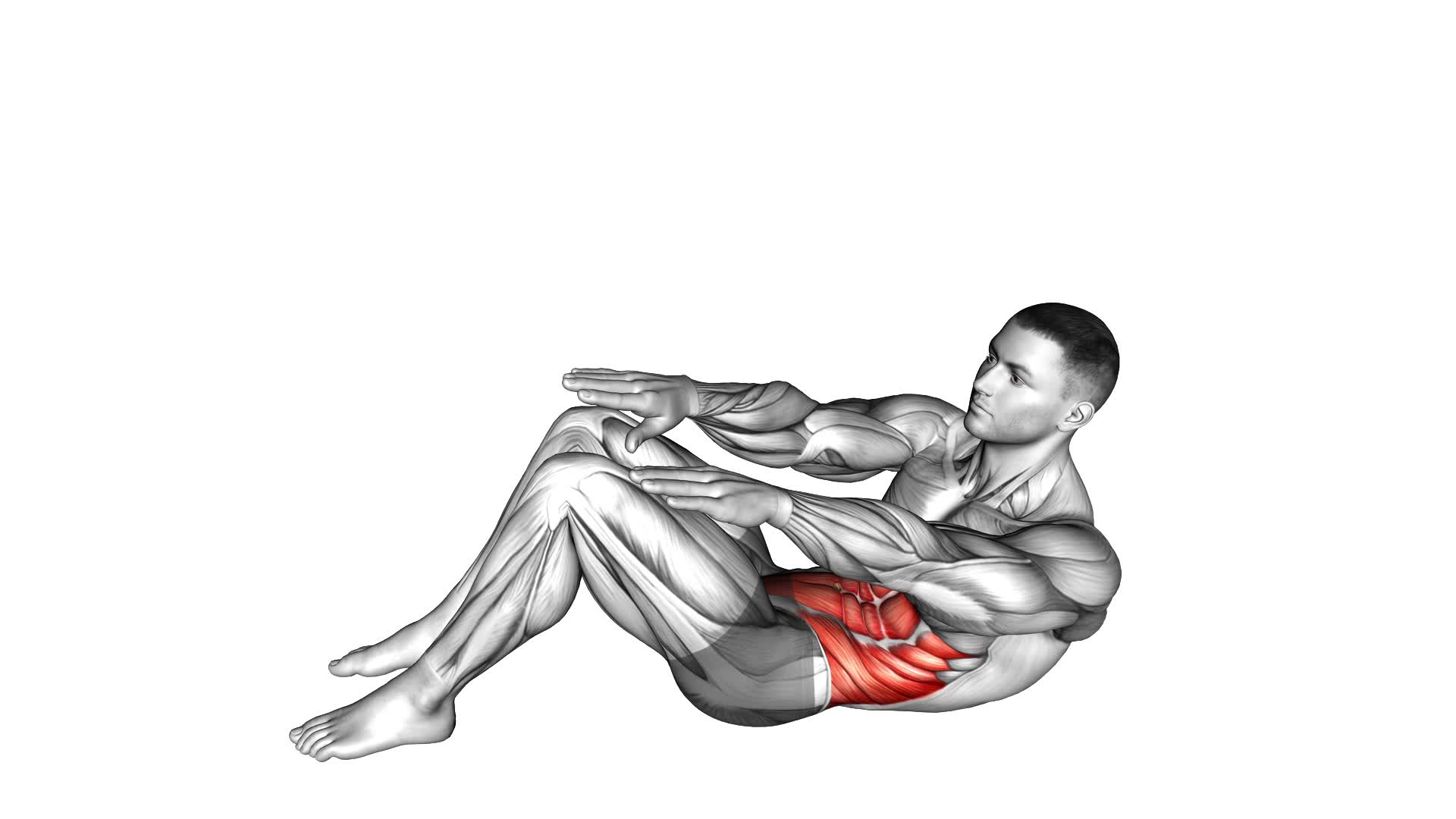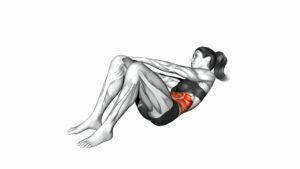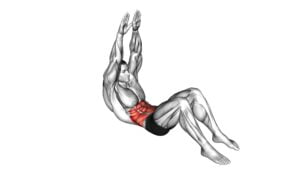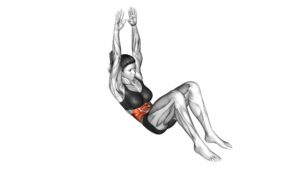Twisting Crunch (Straight Arms) (male) – Video Exercise Guide & Tips

Get ready to strengthen your core with the Twisting Crunch (Straight Arms) exercise!
Watch This Exercise Video
In this video exercise guide, you'll learn the proper form, common mistakes to avoid, and tips to increase intensity.
Designed for advanced users, this challenging variation targets your abs and obliques.
Stay safe by following the included safety precautions and modifications.
Get ready to feel the burn and take your core strength to the next level!
Key Takeaways
- Twisting Crunch (Straight Arms) enhances core strength and targets abs and obliques.
- Proper form and controlled movement are important to maintain during the exercise.
- Engaging the core effectively and avoiding pulling on the neck or using momentum is crucial.
- Modifications can be made to cater to beginners and ensure proper form and safety.
Benefits of Twisting Crunch (Straight Arms)
You will experience enhanced core strength with the Twisting Crunch (Straight Arms). This exercise is one of the most effective core exercises available and offers a variety of twisting crunch variations to target different areas of your core muscles. By incorporating this exercise into your workout routine, you can expect to see improvements in your abdominal muscles, obliques, and lower back.
The Twisting Crunch (Straight Arms) primarily targets the rectus abdominis, commonly known as the six-pack muscles. By engaging your core and twisting your torso, you activate these muscles more effectively than traditional crunches. This exercise also engages the obliques, which are responsible for twisting and rotating movements.
One variation of the Twisting Crunch (Straight Arms) involves using a stability ball. By placing your feet on the ball and performing the twisting crunch, you add an element of instability, forcing your core muscles to work harder to maintain balance.
Another variation is the Twisting Crunch (Straight Arms) with a medicine ball. Holding the medicine ball in your hands while performing the exercise adds resistance and further challenges your core muscles.
Incorporating Twisting Crunch variations into your routine won't only enhance your core strength but also improve your overall stability and balance. Remember to perform the exercise with proper form and gradually increase the difficulty as you progress.
Proper Form for Twisting Crunch (Straight Arms)
To perform the Twisting Crunch (Straight Arms) exercise with proper form, it's important to maintain a stable and controlled movement throughout the entire range of motion. This exercise targets the abdominal muscles, obliques, and hip flexors, and when done correctly, can help strengthen and tone these areas.
To begin, lie flat on your back with your legs bent and feet flat on the ground. Extend your arms straight above your chest, keeping them parallel to the floor. As you initiate the movement, engage your core and lift your shoulders off the ground, bringing your left elbow towards your right knee. Simultaneously, extend your left leg out straight, hovering it just above the ground. Return to the starting position and repeat on the opposite side.
To ensure proper form and avoid common mistakes, be mindful not to strain your neck or pull on your head with your hands. Instead, focus on using your abdominal muscles to initiate the movement. Additionally, maintain a steady pace and avoid jerky or uncontrolled motions, as this can lead to injury.
Common Mistakes to Avoid
To ensure proper form and avoid common mistakes during the twisting crunch (straight arms) exercise, there are a few key points to keep in mind.
- First, focus on maintaining a straight back throughout the movement to engage the core effectively.
- Second, avoid pulling on your neck or using momentum to lift your upper body, as this can strain the neck and reduce the effectiveness of the exercise.
- Lastly, be mindful of any discomfort or pain in your lower back, and modify the exercise if necessary to prevent injury.
Proper Form Tips
Avoid common mistakes by always maintaining proper form during the Twisting Crunch (Straight Arms) exercise. Proper form not only maximizes the effectiveness of the exercise but also helps prevent injuries. Here are some tips to ensure you maintain proper form:
- Engage your core muscles throughout the entire movement to protect your lower back.
- Keep your head and neck in a neutral position, avoiding any strain or tension.
- Maintain a slow and controlled pace, focusing on the contraction of your abdominal muscles.
- Avoid using momentum or swinging your arms to increase the intensity. Instead, focus on squeezing your abs and using your core strength.
Injury Prevention Techniques
You can prevent injuries during the Twisting Crunch (Straight Arms) exercise by implementing proper techniques. Injury prevention techniques are essential to avoiding potential injuries and ensuring a safe workout.
Firstly, it's crucial to maintain good form throughout the exercise. Keep your back straight and engage your core muscles to protect your spine. Avoid using momentum or jerky movements, as this can strain your muscles and joints.
Secondly, start with a suitable weight or resistance level that challenges you without causing strain or excessive stress on your body. Gradually increase the intensity as your strength and flexibility improve.
Finally, always warm up before performing the exercise and stretch afterward to prevent muscle strains and promote recovery.
Tips to Increase Intensity
Increase the intensity of your twisting crunch (straight arms) exercise by incorporating these three key tips:
- Utilize advanced techniques: To take your twisting crunch to the next level, try adding resistance by holding a weight plate or medicine ball against your chest. This will engage your core muscles even more and increase the difficulty of the exercise.
- Focus on effective breathing techniques: Proper breathing is crucial to maximizing the intensity of your workout. Inhale deeply before initiating the crunch, and exhale forcefully as you twist your torso. This will help engage your abdominal muscles and provide more power to your movements.
- Increase the range of motion: To make the exercise more challenging, aim to twist your torso further with each repetition. This will engage more muscles and increase the intensity of the exercise. Just remember to maintain proper form and avoid straining your neck or lower back.
- Gradually increase the repetitions or sets: As you become more comfortable with the exercise, gradually increase the number of repetitions or sets you perform. This progressive overload will help build strength and endurance, leading to greater intensity in your workouts.
By implementing these tips, you can effectively increase the intensity of your twisting crunch (straight arms) exercise and take your core workout to new heights.
Remember to listen to your body and make adjustments as needed to ensure proper form and prevent injury.
Variations for Advanced Users
Take your twisting crunch (straight arms) exercise to the next level with these advanced variations. By incorporating these advanced variations into your routine, you can further challenge your core muscles and increase muscle activation.
One advanced variation is the weighted twisting crunch. To perform this exercise, hold a weight plate or a dumbbell in your hands and extend your arms straight above your chest. As you crunch, twist your torso to one side, bringing your elbow towards the opposite knee. This added resistance will intensify the exercise and engage your core muscles even more.
Another advanced variation is the twisting V-up. Begin by lying on your back with your legs extended and your arms straight above your head. As you crunch, simultaneously lift your legs and torso, reaching your hands towards your feet. Twist your torso to one side, bringing your elbow towards the opposite knee. This exercise targets your abs and obliques while also challenging your balance and coordination.
Incorporating these advanced variations into your twisting crunch (straight arms) exercise will help you take your core workouts to the next level. Remember to maintain proper form and engage your core muscles throughout each repetition for maximum results.
Safety Precautions and Modifications
When it comes to performing the twisting crunch (straight arms) exercise, it's important to prioritize your safety. For beginners, there are safe modifications you can make to ensure proper form and minimize the risk of injury.
Remember to focus on maintaining a strong core and avoid any excessive twisting or jerking motions that could strain your muscles.
Safe Modifications for Beginners
To ensure your safety and provide modifications for beginners, incorporate modifications that cater to your fitness level and abilities. Here are some beginner modifications and safety precautions to keep in mind:
- Start with a smaller range of motion: If you find it challenging to perform the full twisting crunch, begin by twisting your upper body only slightly. Gradually increase the range of motion as you build strength and flexibility.
- Use your hands for support: Place your hands on the sides of your head instead of straightening your arms. This will provide additional support and stability for beginners.
- Perform the exercise on a mat: To protect your lower back and ensure proper alignment, lie down on a comfortable exercise mat while performing the twisting crunch. This will also help cushion your spine and reduce the risk of injury.
- Listen to your body: Pay attention to how your body feels during the exercise. If you experience any discomfort or pain, modify the movement or stop altogether. It's important to prioritize your safety and avoid pushing yourself beyond your limits.
Importance of Proper Form
Maintaining proper form is crucial for ensuring safety and making necessary modifications during the twisting crunch exercise. By focusing on proper form, you can prevent injuries and maximize the effectiveness of the exercise.
One of the key injury prevention techniques is to engage your core muscles throughout the movement. This helps to stabilize your spine and protect your lower back.
Additionally, it's important to avoid jerking or using momentum to perform the exercise. Instead, move in a controlled and deliberate manner, ensuring that you're using your abdominal muscles to initiate the movement.
For beginners, safe modifications can be made by starting with a smaller range of motion and gradually increasing it as your strength and flexibility improve.
Remember to always listen to your body and stop if you feel any pain or discomfort.
Avoiding Potential Injuries
To avoid potential injuries and ensure your safety during the twisting crunch exercise, it's important to follow safety precautions and make necessary modifications.
Here are some tips to help you prevent injuries and protect yourself while performing this exercise:
- Warm up properly before starting the exercise. Engage in dynamic stretches and movements to increase blood flow to your muscles and prepare them for the workout.
- Maintain proper form throughout the exercise. Keep your core engaged, your back straight, and your neck aligned to avoid strain or injury.
- Start with lighter weights or resistance and gradually increase as your strength improves. This will help prevent overexertion and strain on your muscles.
- Listen to your body and stop if you experience any pain or discomfort. Pushing through pain can lead to injuries, so it's important to listen to your body's signals and take breaks when needed.
Frequently Asked Questions
How Many Calories Does the Twisting Crunch (Straight Arms) Exercise Burn?
The twisting crunch (straight arms) exercise is a great way to target your abs and burn calories. By twisting your upper body while keeping your arms straight, you engage your core muscles and increase the intensity of the movement.
While the exact number of calories burned depends on factors like weight and intensity, this exercise can be an effective addition to your workout routine for burning calories and strengthening your abs.
Can Twisting Crunches (Straight Arms) Help Reduce Belly Fat?
Twisting crunches (straight arms) can definitely help reduce belly fat. By incorporating twisting movements into your workouts, you engage the oblique muscles, which can help strengthen and tone the abdominal area.
Twisting crunch variations, like the one demonstrated in the video, target the obliques even more effectively. This exercise not only burns calories but also helps to build core strength and improve overall stability.
How Often Should I Do Twisting Crunches (Straight Arms) to See Results?
To see results from twisting crunches (straight arms), you need to perform them correctly and consistently. Start by lying on your back with your legs bent and your arms straight above your head. As you crunch up, twist your torso to one side, engaging your obliques.
Aim for 3-4 sets of 10-15 repetitions, 3 times a week. To vary your routine, you can try adding weights or performing the exercise on a stability ball.
Remember to always listen to your body and adjust the intensity as needed.
Can Twisting Crunches (Straight Arms) Help Improve Posture?
Twisting crunches (straight arms) can indeed help improve your posture. By incorporating these exercises into your workout routine, you can strengthen your core muscles and increase spinal stability. This, in turn, can lead to better posture and alignment.
To perform twisting crunches correctly, start by lying on your back with your arms straight above your chest. As you crunch up, twist your torso to one side, engaging your oblique muscles. Remember to maintain proper form and engage your core throughout the exercise.
Are Twisting Crunches (Straight Arms) Suitable for People With Lower Back Pain?
Twisting crunch variations can be beneficial for core strength. However, it's important to consider modifications for lower back pain.
Twisting crunches (straight arms) may not be suitable for individuals with lower back pain. This is because they can put additional strain on the lower back. Instead, it's better to focus on alternative exercises that target the core without exacerbating your pain.
To find exercises that are safe and effective for your specific needs, it's recommended to consult with a fitness professional or physical therapist. They can provide guidance and help you find exercises that will help strengthen your core without causing further discomfort.
Conclusion
In conclusion, the twisting crunch with straight arms is a highly effective exercise for strengthening the core muscles and improving overall body stability. By performing this exercise with proper form and avoiding common mistakes, individuals can maximize the benefits and increase the intensity as needed.
Advanced users can also explore variations to challenge themselves further. It's important to prioritize safety and make necessary modifications based on individual fitness levels and limitations.
Overall, the twisting crunch is a valuable addition to any workout routine.

Author
Years ago, the spark of my life’s passion ignited in my mind the moment I stepped into the local gym for the first time. The inaugural bead of perspiration, the initial endeavor, the very first surge of endorphins, and a sense of pride that washed over me post-workout marked the beginning of my deep-seated interest in strength sports, fitness, and sports nutrition. This very curiosity blossomed rapidly into a profound fascination, propelling me to earn a Master’s degree in Physical Education from the Academy of Physical Education in Krakow, followed by a Sports Manager diploma from the Jagiellonian University. My journey of growth led me to gain more specialized qualifications, such as being a certified personal trainer with a focus on sports dietetics, a lifeguard, and an instructor for wellness and corrective gymnastics. Theoretical knowledge paired seamlessly with practical experience, reinforcing my belief that the transformation of individuals under my guidance was also a reflection of my personal growth. This belief holds true even today. Each day, I strive to push the boundaries and explore new realms. These realms gently elevate me to greater heights. The unique combination of passion for my field and the continuous quest for growth fuels my drive to break new ground.







